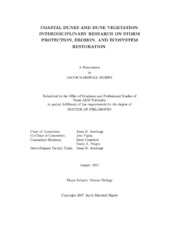| dc.description.abstract | Coastal dunes offer many communities around the world a means to naturally mitigate
the damage caused by coastal storms. This dissertation will address some of the
knowledge gaps concerning the cost effectiveness of dunes in terms of storm damage
mitigation, the role of dune vegetation in erosion resistance during storm surges, and
the best techniques for restoring dune vegetation. To determine dune storm damage
mitigation value, Hurricane Ike FEMA insurance claims for over one thousand homes
in Galveston County, Texas, were analyzed (multivariate regression) with respect to
the size of the dunes protecting those homes. The dunes in this area provided over 8
million dollars in protection across the study area during Hurricane Ike. Dunes were
generally cost-effective (>$50 of damage mitigation per cubic meter of dune sediment)
and were a viable hazard mitigation strategy. With regards to dune vegetation's role
in erosion resistance, the effects of different plant features and species on swash hydrodynamics, sediment properties, and erosion was evaluated utilizing multivariate
regression and a simulated storm surge/wave attack within a wave flume. Aboveground
plant surface area was significantly related to decreased swash flow velocity,
turbulent kinetic energy, and wave reflection while fine root biomass density was
significantly related to increased sediment shear strength. These results indicated
that both above- and below-ground features of plants play a role in reducing dune
erosion during storm surges. Lastly, a variety of dune restoration techniques and the
broader ramifications of planting vegetation on dune biogeomorphology were evaluated
to identify effective dune restoration practices for the Texas Coast. Sargassum
baling, useful for transporting the nuisance seaweed from beaches, was minimally
impactful on plant growth while using rooted plants and native mycorrhizal fungal
inoculations generally increased the accumulation of plant biomass. Dune vegetation
planting also initially promoted accretion but lowered plant diversity compared to
a naturally colonized dune. The research detailed in this dissertation contributes
to the growing body of knowledge concerning engineering with nature and provides
additional support for the integration of coastal dune restoration into sustainable
coastal hazard mitigation strategies. | en |


